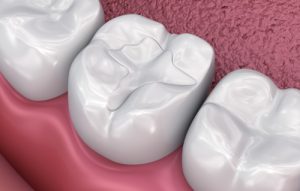Restore Your Smile with Dental Fillings in Kingwood, TX
 Dental fillings are a simple yet effective way to repair teeth damaged by decay or minor fractures. When a cavity forms, the affected portion of the tooth is removed, and a filling is placed to restore the tooth’s structure and functionality. This not only prevents further damage but also protects your overall oral health.
Dental fillings are a simple yet effective way to repair teeth damaged by decay or minor fractures. When a cavity forms, the affected portion of the tooth is removed, and a filling is placed to restore the tooth’s structure and functionality. This not only prevents further damage but also protects your overall oral health.
Dr. Derek Scott, a trusted dentist in Kingwood, TX, and nearby areas like Humble, Atascocita, and Porter, provides high-quality dental fillings to help you maintain a healthy, beautiful smile. To learn more about the benefits of dental fillings, contact Dr. Scott’s dental office by calling about the potential complications of dentures, contact Dr. Scott’s dental office today by calling (281) 358-3125.
Types of Dental Fillings
Different materials are used for dental fillings, each with its benefits. Dr. Scott will guide you in choosing the best dental filling option based on your dental needs and lifestyle.
Dental Amalgam Fillings
- Made from a mixture of metals, including silver, mercury, and copper.
- Durable and ideal for molars that handle heavy chewing.
- Budget-friendly but noticeable due to their metallic color.
Composite Fillings
- Tooth-colored resin that blends with your natural teeth.
- Perfect for visible areas like front teeth.
- Less durable than amalgam but offers a more aesthetic finish.
Ceramic Fillings
- Made of porcelain and highly resistant to stains.
- Natural appearance and long-lasting.
- Typically more expensive than other options.
Glass Ionomer Fillings
- Blend of acrylic and glass.
- Release fluoride to help protect against decay.
- Best for small cavities or temporary solutions.
Gold Fillings
- Made of gold alloy, offering unmatched durability and longevity.
- Resistant to corrosion and extremely strong, lasting 15 years or more.
- Expensive and more noticeable, often preferred by those seeking a premium solution.
The Dental Filling Procedure
Getting a tooth filling is a straightforward procedure, typically completed in a single visit to Dr. Scott’s office. Here’s what to expect:
- Examination and Diagnosis: Dr. Scott will examine your teeth and may take X-rays to assess the extent of decay.
- Numbing the Area: A local anesthetic is applied to ensure you’re comfortable during the procedure.
- Removing the Decay: The decayed portion of the tooth is carefully removed.
- Placing the Filling: The chosen filling material is applied, shaped, and hardened with a special light (if applicable).
- Polishing: The final step involves smoothing and polishing the filling for a natural feel.
Caring for Your Dental Fillings
To keep your tooth-colored fillings in good condition:
- Brush twice daily and floss regularly.
- Avoid chewing hard foods like ice or popcorn kernels.
- Visit Dr. Scott for regular checkups and dental cleanings.
Who’s a Candidate for Dental Fillings?

- Cavities: The most common reason for dental fillings. Cavities are formed when bacteria produce acids that eat away at the enamel.
- Chipped or cracked teeth: If you’ve damaged a tooth from injury or wear, a filling can restore its function.
- Tooth sensitivity: Persistent sensitivity to hot, cold, or sweet foods could indicate the need for a filling.
- Decay that hasn’t reached the pulp: Fillings are often recommended when decay is caught early, before it reaches the inner parts of the tooth, which could require more complex treatment.
If you’re experiencing any of these issues, it’s best to schedule a consultation with Dr. Scott by calling (281) 358-3125 to determine if a dental filling is the right treatment for you.
Cost of Dental Fillings
The cost of dental fillings can vary depending on several factors, including the type of filling material used, the location of the cavity, and whether your insurance covers the procedure. Here’s an overview of potential costs:
- Amalgam Fillings (Silver): These are typically the most affordable option, costing anywhere between $100 to $250 per tooth.
- Composite Fillings (Tooth-Colored): These are a bit pricier, generally ranging from $150 to $400 per tooth.
- Ceramic Fillings (Porcelain): Ceramic fillings, which offer a natural look, can cost between $300 to $700 per tooth.
- Glass Ionomer Fillings: These are typically the least expensive, averaging between $100 to $200 per tooth.
Dr. Scott offers flexible payment options to help you manage the cost of your dental fillings, and he works with many dental insurance providers to ensure you get the care you need without unnecessary financial strain.
See Why Patients Choose Dr. Derek Scott
At Dr. Scott’s dental office patients experience compassionate care and exceptional results. Dr. Scott’s dedication to making dental visits comfortable and stress-free has earned him the trust and loyalty of his patients. Here’s what one of our happy patients had to say:
“Dr. Scott is an amazing dentist. I am one of those who was also terrified of going to the dentist. Last year was my first time going to the dentist in about 10 years because of fear. I researched dentists in the area, and Dr. Scott far exceeded my expectations of what I was looking for in a dentist, so I decided to try him out. Last year he pulled one of my teeth. Just in this week alone, I’ve gotten a crown, a cleaning, and 5 fillings. I’m not even afraid to go to the dentist anymore. The whole staff is wonderful and will make you feel at ease from the moment you walk through the front door. I highly recommend Dr. Scott!!!! I just wish this rating system had more stars!!!” – Trish Harbin
Dr. Scott takes pride in helping patients overcome dental anxiety while delivering top-notch dental care. Whether it’s a routine cleaning or advanced restorative work, you can trust Dr. Scott to prioritize your comfort and well-being every step of the way.
Frequently Asked Questions
The process of getting a dental filling is usually painless. Before beginning the procedure, the dentist will administer a local anesthetic to numb the area around the tooth. This ensures that you won’t feel any pain during the cavity removal or filling placement. Some patients might experience mild discomfort or sensitivity after the anesthesia wears off, but this is temporary and can be managed with over-the-counter pain relievers.
The lifespan of a dental filling varies depending on factors such as the type of material used, the location of the filling, and the individual’s oral hygiene habits. Amalgam fillings can last for decades, while composite resin fillings might need replacement after around 5 to 10 years. Regular dental check-ups can help monitor the condition of your fillings and detect any signs of wear or damage, ensuring timely maintenance or replacement if necessary.
Protect Your Smile with Dental Fillings
Dental fillings are a necessary part of maintaining your oral health and protecting your teeth from further damage. Whether you’re dealing with a cavity or need a replacement filling, Dr. Scott helps patients in Kingwood, Atascocita, Porter, Houston and the nearby areas. His patient-centered approach ensures you receive the care and attention you deserve.
Schedule your appointment with Dr. Derek Scott today by calling (281) 358-3125 to take the first step toward a healthier smile!